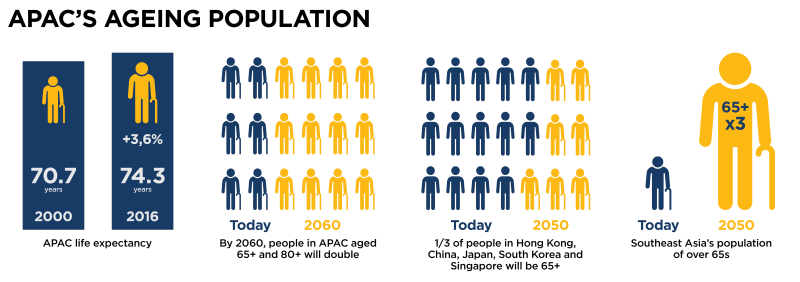Over the past five years, Asia Pacific countries have been investing heavily in the health of their nations and in many countries, healthcare spending has exceeded economic growth. While countries across the region face similar challenges, it is a cultural hotspot with differing population needs, economic wealth distribution, and healthcare systems, and their responses to dealing with these challenges vary greatly depending on economic, political and social conditions.
The prosperity that is spreading across the APAC region, gives a strong indication for continued healthcare spending, but the challenge is to direct that spend towards solutions that offer the greatest value for money while having the biggest impact on individual and collective health outcomes.
Digital health solutions accelerated by Covid-19
While the immediate impact of Covid-19 is putting pressure on healthcare systems across the APAC region, it has also accelerated key digitalisation trends in the healthcare sector. Telehealth has quickly provided digital solutions for online consultations and prescription renewal appointments where physical examinations have not been possible. Countries including Indonesia, Singapore and China have online platforms that have facilitated this shift, but further development and solutions are required across the region to implement long-term, robust digitalised solutions.
The life sciences and pharmaceutical arena are forging ahead with leveraging ICT to improve patient engagement, product development, and drive cost efficiencies. AI has already shown potential to analyse large data sets from clinical trials, health records, genetic profiles, and pre-clinical studies. A growing number of bio-pharma companies are using AI to streamline the drug discovery process. In Japan, South Korea and India AI is being implemented in aged care, cancer treatment and planning and to improve rural healthcare access.
“APAC is set to become the world’s second largest MedTech market, but Swedish companies will need to navigate key challenges. Opportunities exist for Swedish companies if they collaborate with local stakeholders and laying a strong foundation within the growing competitive landscape.”In the area of cell and gene therapy, China, Japan and South Korea have invested over the past few decades in gene medicine research and development, which has the potential for customised and targeted patient treatment.
While these projects and investments vary in their development phases, the potential for collaboration is vast. These technologies are helping to drive change by making healthcare delivery less expensive, more efficient and accessible while at the same time speeding up access and enabling greater flexibility in the life sciences sector.

R&D high on the agenda for countries and companies
Western healthcare and pharmaceutical companies are under increasing pressure to commercialise their products, while also attract the right patient recruitment and meet domestic regulatory policies. Asian countries are increasingly viewed as viable options for clinical trials and the contract research organisation market in APAC is the fastest growing in the world. Estimates indicate that market revenue will increase to 20% CAGR between 2016 and 2021, compared with the global rate of 11.4% CAGR.
The sector growth is driven by a combination of critical factors including access to a large patient pool, skilled labour force, fast-growing pharmaceutical market, harmonised environment and stronger intellectual property rights, and the reduction of drug lag.
Swedish collaboration and expertise a natural fit
Both economic growth, urbanisation and population growth is driving the demand for greater quality care and innovative medicines and a shift away from volume to value-based healthcare. This shift is influencing the way life science and healthcare companies currently do business in the region as well as the dynamics for future collaborations. There are no one-size fits all approaches in the diverse cultural and political and business landscape of APAC where demographics, regulatory environments, and disease profiles can determine an approach. Domestic companies are often strong in the market, offering cost-effective solutions and driving competition. The current global healthcare crisis has only reinforced the importance of regionalisation, where production and sourcing are moved closer to end user and companies develop local or regional supply chains.
Singapore is one country that is becoming a key player in medical manufacturing and opportunities are available to collaborate to help realise government initiatives focusing on several technologies including 3D printing, robotics, IoT and more. The Singapore Research, Innovation and Enterprise plan alone has allocated SD 3.2 billion to advanced manufacturing and engineering research through 2020.
Swedish companies who can collaborate and help governments and private stakeholders realise their life science and healthcare goals are in a strong position to grow alongside local stakeholders in a very competitive landscape. In the next few years, APAC is set to become the world’s second largest MedTech market, bringing unique opportunities for Swedish companies to provide resources, equipment, and knowledge for stronger and future-proof healthcare and life science sectors.





